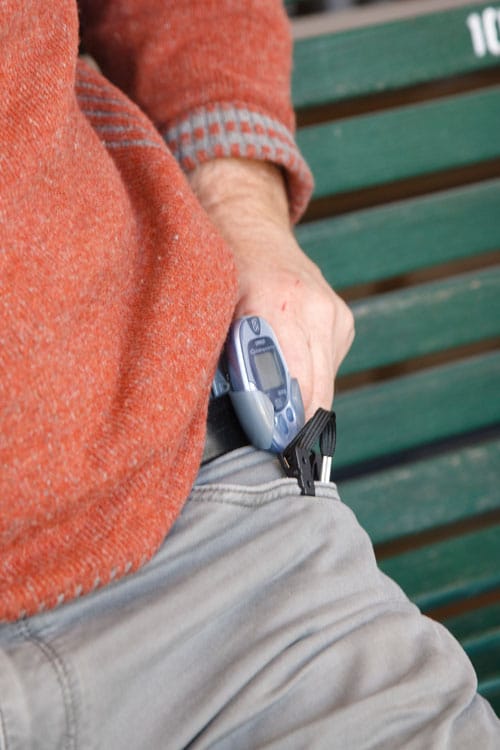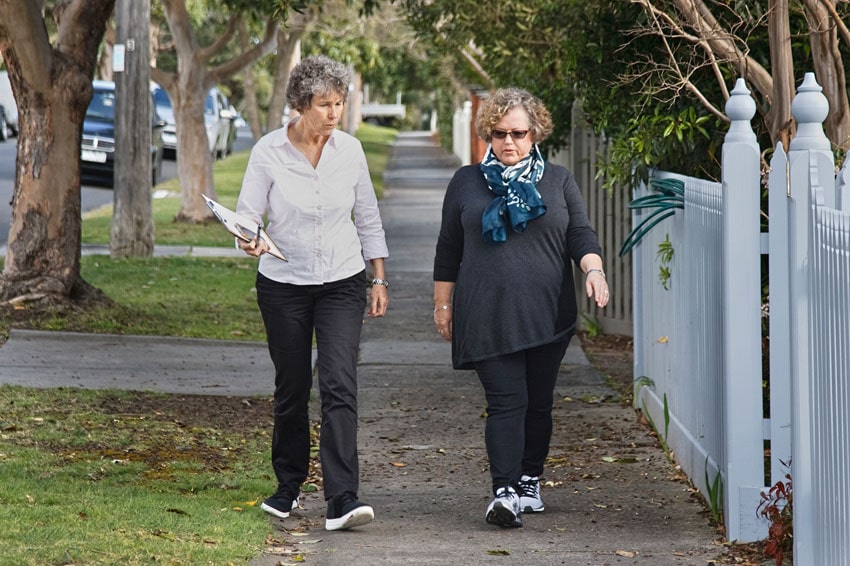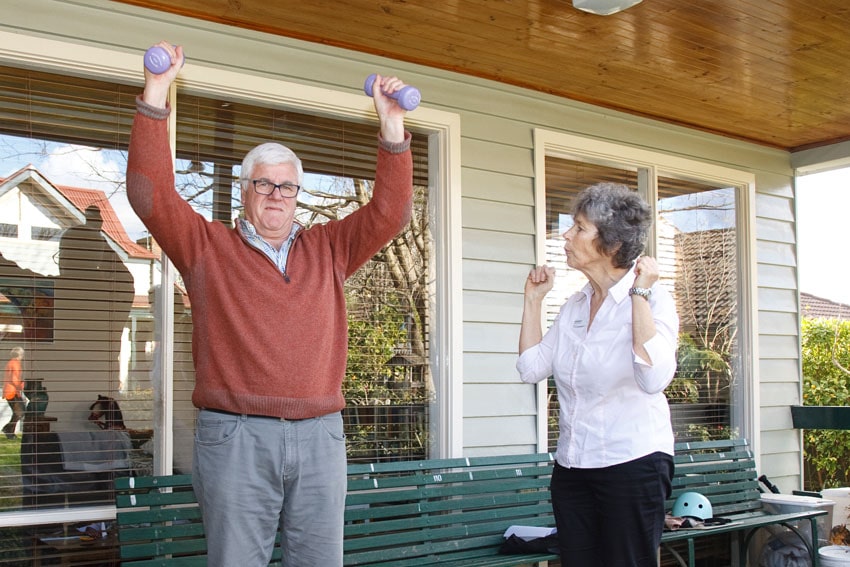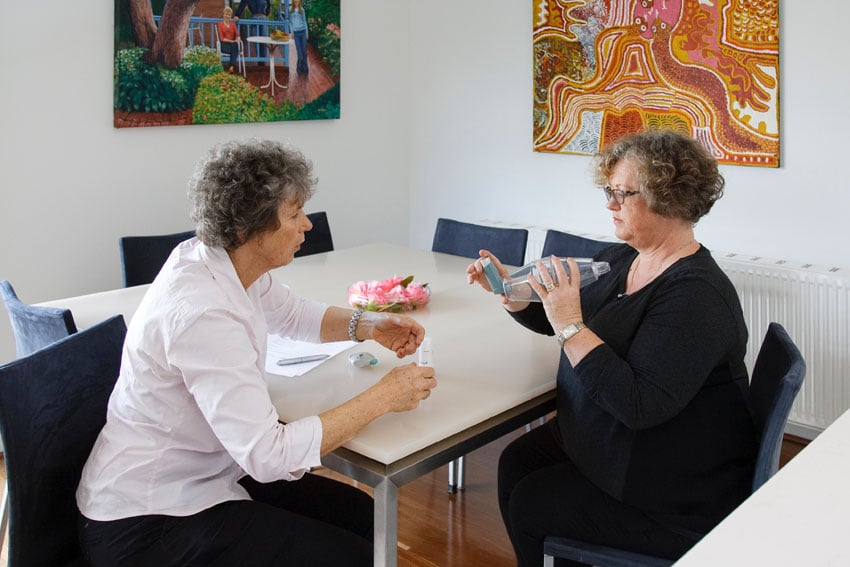Assessment > Home Visit
Home Visit
Home Visit Menu
The Home Visit
Before entering the home, if alone, SMS or ring a colleague and confirm your location and estimated time of departure.
Confirm consent from the patient on arrival – this may include signing a Patient Consent Form
Explain the structure of the program:
Exercise program prescribed today
Patient performs exercise routine at home or in the local area at least 5 times per week
Visiting health professional will call at a designated time every week for 7 weeks to discuss their progress and any health issues
Patient will be contacted to attend the hospital or community health centre for a follow up assessment at the completion of the program
Arrange the weekly appointment time for calls from the health professional. Explain that this is a professional appointment. If the patient is not able to keep the appointment they need to email, SMS or phone the person(s) listed on their home diary to re-schedule their phone call session.
Confirm that the patient knows who to contact if they have any issues that need to be answered before their weekly call.
Aerobic Training

Discuss which measurement tool they plan to use and set up as necessary:
- Pedometer
- Fitbit
- Mobile phone app
- Number of houses in the street
- Laps of their corridor
Practice Walk

- Weather permitting, take the patient for at least a 10 minute walk in the area where they plan to do their regular walks – assess the suitability of their footwear and the proposed walking environment
- Monitor exercise intensity (using a scale of 6-20)
- Monitor shortness of breath (using a scale of 0-10)
- Discuss shortness of breath and how it relates to the intensity of their walks – they should aim to rate their breathing so that they feel moderately short of breath (3 to 4 out of 10)
- If necessary, explain interval training – it is more beneficial to train at the correct intensity with stops than to train at a low intensity without stopping
How to prescribe exercise intensity
Taking into account the results of the field walking test (6MWT or ISWT) or modified incremental step test (MIST), and the 10 minute walk at home, prescribe the lower limb endurance component of their program.
Walking Training
For walking training aim for 20 mins total endurance exercise at an intensity of 80% of their 6 Minute Walk Test (6MWT) distance.
If walking inside home, measure the track length with a measuring wheel and prescribe either by time, distance or pedometer steps:
- Distance: calculate 80% of 6MWT speed and convert to distance that would be walked in approximately 20 minutes. Measure with pedometer if appropriate.
- Time: for lower level patients – ask to walk for a designated time (eg 10 mins x 2) on a walking track of known distance and ask the patient to record the number of laps
- Pedometer steps: calculate 80% of 6MWT steps and convert to steps in 20 minutes (least preferred option)
Step Training
For step training, aim for 20mins of cumulative stepping. This may be broken into shorter periods interspersed with rest breaks.
The initial training load for endurance step training is equivalent to 44% of the final MIST level achieved e.g. if a participant finished the MIST on level 10, initial step training would be prescribed at level 4. Select the corresponding audio level for endurance step training here.
Strength Training
As well as lower limb endurance training (such as walking), a pulmonary rehabilitation program should also include:
Some patients may also require stretching and balance exercises as per their assessment.

Prescribing strength training
Both upper and lower limb strength training exercises are recommended. Generally, two upper limb and two lower limb exercises are prescribed but this will depend on the patients’ co-morbidities.
See examples in:


The following exercises are preferred examples of upper limb strength training exercises in the home but may need to be modified or substituted based on the patients’ co-morbidities:
- Wall push ups – body weight
- Biceps curls*
- Shoulder press*
- Standing row*
* Patients may choose to use purchased weights or use home items such as packets of spaghetti or bottles filled with water.


The following exercises are preferred examples of lower limb strength training exercises in the home (weights can be added if progression is required):
- Step ups – body weight (weights in the hands if prescribed)
- Sit to stand – body weight (alter the position of the feet and/or the height of the chair for progression)


For more information on exercise prescription, go to the Pulmonary Rehabilitation Toolkit.
Home Diary
To assist with feedback and encourage adherence to the program, the patient is asked to complete a home exercise diary.
The following are useful resources:
Information completed in the diary is also used by the patient to provide feedback to the health professional during their weekly telephone calls.
It is important for the health professional completing the home visit to explain the contents and importance of the Home Diary to the patient.
In particular, patients must be alerted to the section on exercise safety- Before you exercise
Key pages of the Home Exercise Diary include:
1. My Exercise Goals – Week 1
- Explain the page
- Assist the patient in filling in this page
- Use Motivational Interviewing skills to discuss the confidence level they have selected
2. My Exercise Goals – Week 2
- Explain to the patient how to complete this page including the definition of a flare up
- Complete the “My endurance exercises” section with the prescribed exercises
- Complete the “My strengthening exercises” section with the prescribed exercises
3. Improving Your Health
- Explain to patient that this is the education component of the program
- During the weekly telephone calls the health professional will give the patient the opportunity to discuss any medical issues related to their respiratory condition
- Whilst discussing this section, check their inhaler technique if appropriate
Review of Inhaler / Devices Technique
During the home visit, elements of the self-management program that cannot be adequately discussed by subsequent telephone follow up should be reviewed. This may include review of the patients’ inhaler technique and airway clearance devices.
See – National Asthma Council for videos demonstrating inhaler technique and cleaning of devices.
See – Bronchiectasis Toolbox for videos demonstrating airway clearance techniques and cleaning of devices.
Home Visit Checklist
Prior to finishing the home visit and leaving the home – complete the Home visit checklist

